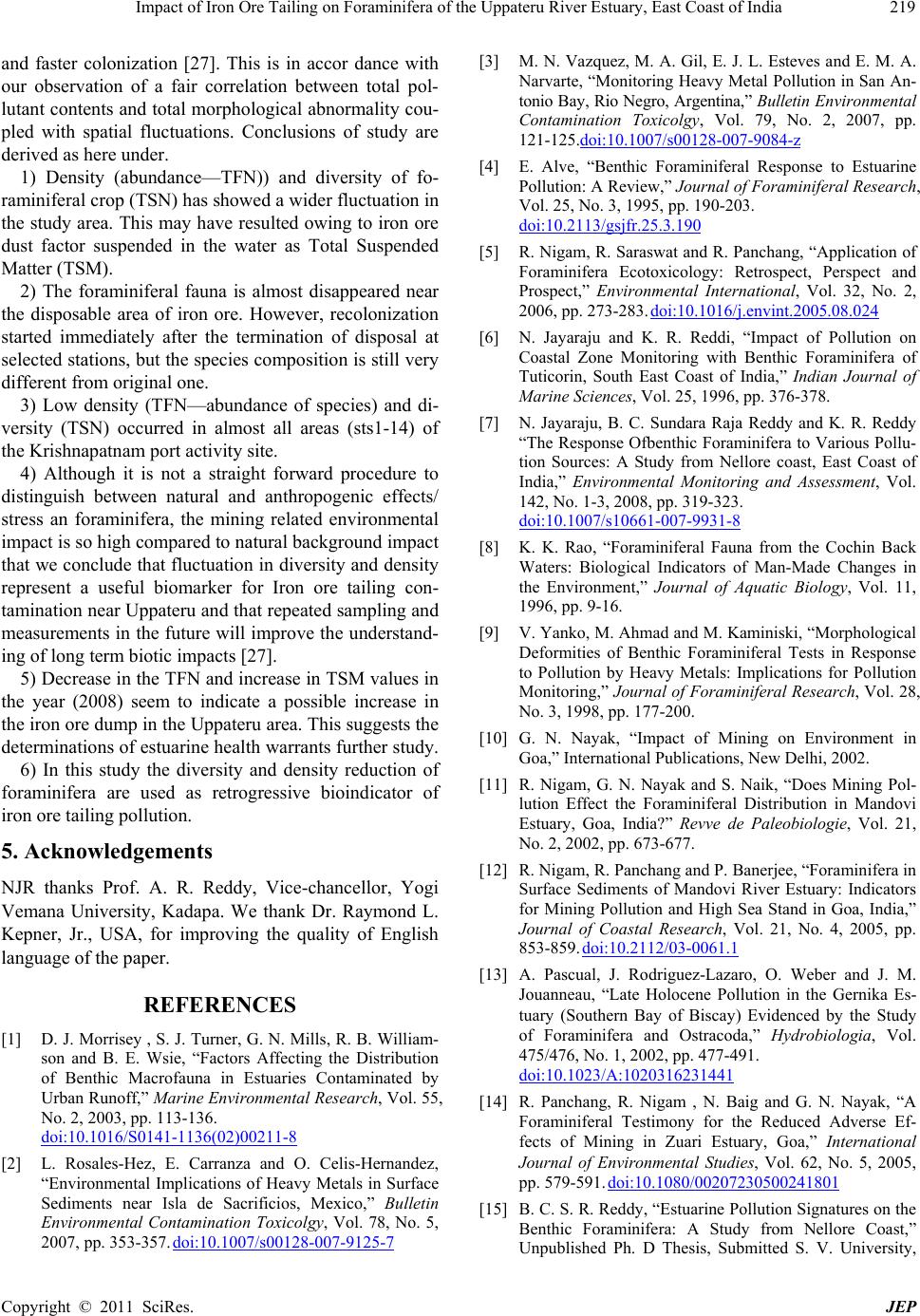
Impact of Iron Ore Tailing on Foraminifera of the Uppateru River Estuary, East Coast of India 219
and faster colonization [27]. This is in accor dance with
our observation of a fair correlation between total pol-
lutant contents and total morphological abnormality cou-
pled with spatial fluctuations. Conclusions of study are
derived as here under.
1) Density (abundance—TFN)) and diversity of fo-
raminiferal crop (TSN) has showed a wider fluctuation in
the study area. This may have resulted owing to iron ore
dust factor suspended in the water as Total Suspended
Matter (TSM).
2) The foraminiferal fauna is almost disappeared near
the disposable area of iron ore. However, recolonization
started immediately after the termination of disposal at
selected stations, but the species composition is still very
different from original one.
3) Low density (TFN—abundance of species) and di-
versity (TSN) occurred in almost all areas (sts1-14) of
the Krishnapatnam port activity site.
4) Although it is not a straight forward procedure to
distinguish between natural and anthropogenic effects/
stress an foraminifera, the mining related environmental
impact is so high compared to natural background impact
that we conclude that fluctuation in diversity and density
represent a useful biomarker for Iron ore tailing con-
tamination near Uppateru and that repeated sampling and
measurements in the future will improve the understand-
ing of long term biotic impacts [27].
5) Decrease in the TFN and increase in TSM values in
the year (2008) seem to indicate a possible increase in
the iron ore dump in the Uppateru area. This suggests the
determinations of estuarine health warrants further study.
6) In this study the diversity and density reduction of
foraminifera are used as retrogressive bioindicator of
iron ore tailing pollution.
5. Acknowledgements
NJR thanks Prof. A. R. Reddy, Vice-chancellor, Yogi
Vemana University, Kadapa. We thank Dr. Raymond L.
Kepner, Jr., USA, for improving the quality of English
language of the paper.
REFERENCES
[1] D. J. Morrisey , S. J. Turner, G. N. Mills, R. B. William-
son and B. E. Wsie, “Factors Affecting the Distribution
of Benthic Macrofauna in Estuaries Contaminated by
Urban Runoff,” Marine Environmental Research, Vol. 55,
No. 2, 2003, pp. 113-136.
doi:10.1016/S0141-1136(02)00211-8
[2] L. Rosales-Hez, E. Carranza and O. Celis-Hernandez,
“Environmental Implications of Heavy Metals in Surface
Sediments near Isla de Sacrificios, Mexico,” Bulletin
Environmental Contamination Toxicolgy, Vol. 78, No. 5,
2007, pp. 353-357. doi:10.1007/s00128-007-9125-7
[3] M. N. Vazquez, M. A. Gil, E. J. L. Esteves and E. M. A.
Narvarte, “Monitoring Heavy Metal Pollution in San An-
tonio Bay, Rio Negro, Argentina,” Bulletin Env ironm ental
Contamination Toxicolgy, Vol. 79, No. 2, 2007, pp.
121-125.doi:10.1007/s00128-007-9084-z
[4] E. Alve, “Benthic Foraminiferal Response to Estuarine
Pollution: A Review,” Journal of Foraminiferal Research,
Vol. 25, No. 3, 1995, pp. 190-203.
doi:10.2113/gsjfr.25.3.190
[5] R. Nigam, R. Saraswat and R. Panchang, “Application of
Foraminifera Ecotoxicology: Retrospect, Perspect and
Prospect,” Environmental International, Vol. 32, No. 2,
2006, pp. 273-283. doi:10.1016/j.envint.2005.08.024
[6] N. Jayaraju and K. R. Reddi, “Impact of Pollution on
Coastal Zone Monitoring with Benthic Foraminifera of
Tuticorin, South East Coast of India,” Indian Journal of
Marine Sciences, Vol. 25, 1996, pp. 376-378.
[7] N. Jayaraju, B. C. Sundara Raja Reddy and K. R. Reddy
“The Response Ofbenthic Foraminifera to Various Pollu-
tion Sources: A Study from Nellore coast, East Coast of
India,” Environmental Monitoring and Assessment, Vol.
142, No. 1-3, 2008, pp. 319-323.
doi:10.1007/s10661-007-9931-8
[8] K. K. Rao, “Foraminiferal Fauna from the Cochin Back
Waters: Biological Indicators of Man-Made Changes in
the Environment,” Journal of Aquatic Biology, Vol. 11,
1996, pp. 9-16.
[9] V. Yanko, M. Ahmad and M. Kaminiski, “Morphological
Deformities of Benthic Foraminiferal Tests in Response
to Pollution by Heavy Metals: Implications for Pollution
Monitoring,” Journal of Foraminiferal Research, Vol. 28,
No. 3, 1998, pp. 177-200.
[10] G. N. Nayak, “Impact of Mining on Environment in
Goa,” International Publications, New Delhi, 2002.
[11] R. Nigam, G. N. Nayak and S. Naik, “Does Mining Pol-
lution Effect the Foraminiferal Distribution in Mandovi
Estuary, Goa, India?” Revve de Paleobiologie, Vol. 21,
No. 2, 2002, pp. 673-677.
[12] R. Nigam, R. Panchang and P. Banerjee, “Foraminifera in
Surface Sediments of Mandovi River Estuary: Indicators
for Mining Pollution and High Sea Stand in Goa, India,”
Journal of Coastal Research, Vol. 21, No. 4, 2005, pp.
853-859. doi:10.2112/03-0061.1
[13] A. Pascual, J. Rodriguez-Lazaro, O. Weber and J. M.
Jouanneau, “Late Holocene Pollution in the Gernika Es-
tuary (Southern Bay of Biscay) Evidenced by the Study
of Foraminifera and Ostracoda,” Hydrobiologia, Vol.
475/476, No. 1, 2002, pp. 477-491.
doi:10.1023/A:1020316231441
[14] R. Panchang, R. Nigam , N. Baig and G. N. Nayak, “A
Foraminiferal Testimony for the Reduced Adverse Ef-
fects of Mining in Zuari Estuary, Goa,” International
Journal of Environmental Studies, Vol. 62, No. 5, 2005,
pp. 579-591. doi:10.1080/00207230500241801
[15] B. C. S. R. Reddy, “Estuarine Pollution Signatures on the
Benthic Foraminifera: A Study from Nellore Coast,”
Unpublished Ph. D Thesis, Submitted S. V. University,
Copyright © 2011 SciRes. JEP